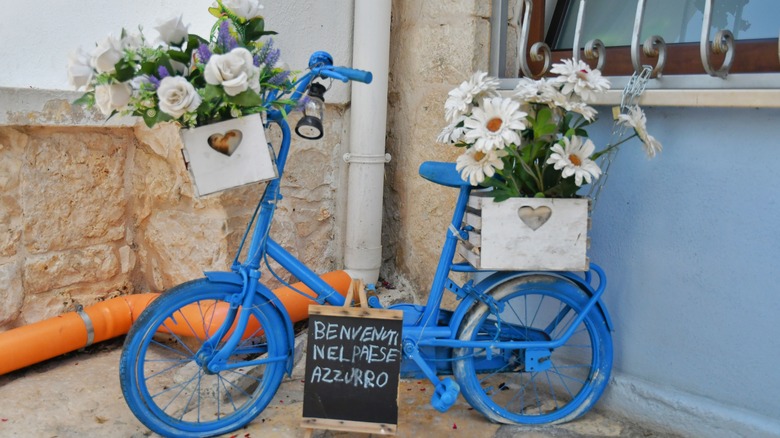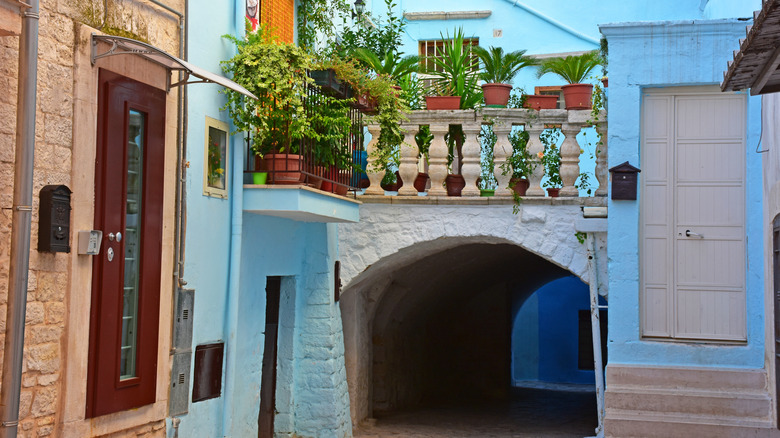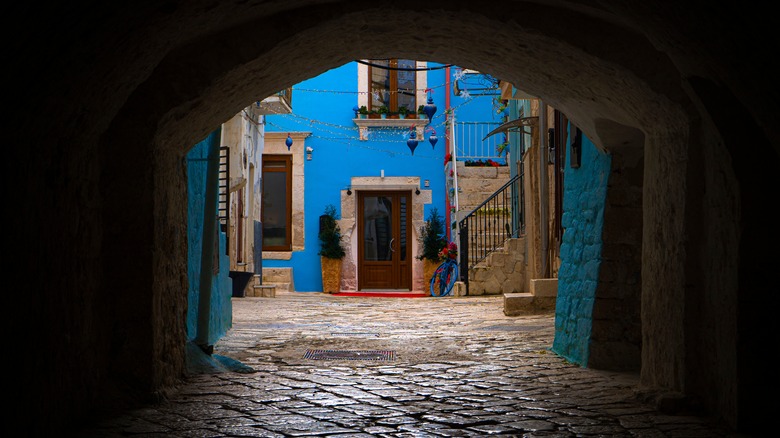This Little-Known Italian City Is Perfectly Pastel Blue Everywhere You Turn
"Benvenuti nel Paese Azzurro," reads the sign on a blue bicycle in a lovely Italian town in Puglia, Italy. It means, "Welcome to the Blue Country," and it's there for a great reason. The town is Casamassima, and a good number of the buildings here are painted a pretty blue color. There are different shades, and everywhere you look, this soothing color adorns the walls, the balconies, the flower pots, and more.
As it turns out, there are several versions of the local legend of why the color is there in the first place. One of them even has a bit of a scientific basis, believe it or not. In addition to being one of the most scenic towns in Italy for that perfect social media shot, it's also quiet as far as tourism goes. Outside of taking pictures of yourself in front of blue walls, there is quite a bit to do here. Let's take a look at the blue village of Casamassima, Italy, what to do there, and the legend behind the paint job that has been around for over four centuries.
Why Casamassima, Italy, is painted blue
Casamassima sits at the top of Italy's boot heel (Puglia), about a 20-minute drive from Bari. You can also take the train from Bari Centrale station to reach here. The city walls date back to around the 10th century, and it was largely agricultural.
In the year 1600, the walls were painted blue. There are variations to the story of how this came to be. In one, the local ruler ordered that the quicklime used to whitewash the walls be tinted blue — in honor of the Virgin Mary – to keep the populace from contracting a plague which had hit the region. (Blue often symbolizes the purity of the Virgin in art and is usually the color of her veil and sometimes garment) In another, it was painted blue to honor the Virgin Mary for helping the village survive the devastating plague after the outbreak.
It's interesting to note that in Ostuni, Italy — about 1.5 hours away from Casamassima by car — the walls were painted all white around the same time, using limestone whitewash. Whitewash is actually known to help combat bacteria, though that wasn't understood back then. In the 1960s, artist Vittorio Viviani called Casamassima "Il Paese Azzurro," which stuck. (Much as English has the words "pink" and "red" for light and dark red, Italian uses "blu" to indicate a dark blue and "azzurro" for a lighter, sky blue.)
What to do in the Blue Village
Casamassima has a bunch of lovely things to do while you visit. You should walk through the Arco delle Ombre, or the Passage of Shadows, an archway that opened to townspeople in 1861 during the Italian unification. However, it was dark there, and people had to carry their own lights, casting long shadows that created the illusion of ghosts. You can also pay a visit to the Clock Gate from 1841, which welcomes you at the entrance of the town.
In the center of the village, you'll find the Chiesa Matrice Parrocchia Santa Croce, which was finished in 1321 and was an expansion of an earlier church from around a century before. Don't miss the statue of the town protector, San Rocco da Montpellier, inside. You should also stop by the Monastery of Santa Chiara, founded by Antonio Acquaviva d'Aragona in the 16th century. First, it was used as an orphanage, and in 1660, it became a monastery. In 1900, the building functioned as a prison, then after that, a school. These days, it houses a museum that you can visit. There are also the castles Palazzo Monacelle (once a musical conservatory for women) and Palazzo Ducale to check out.


